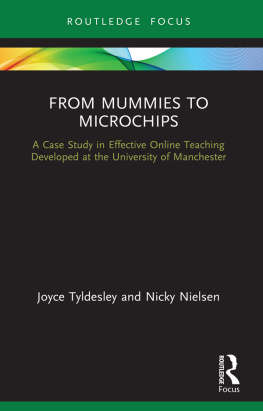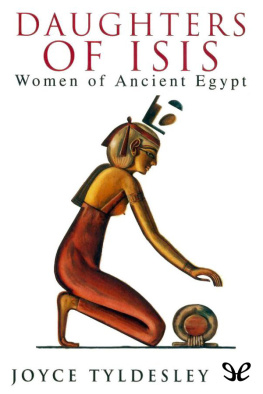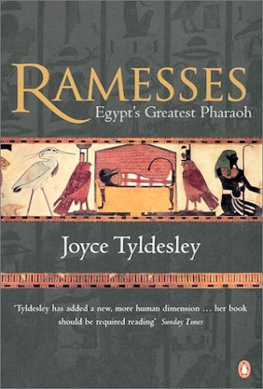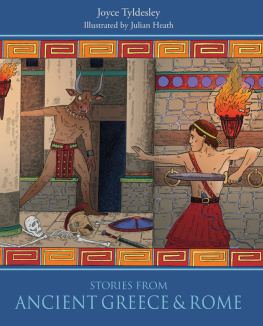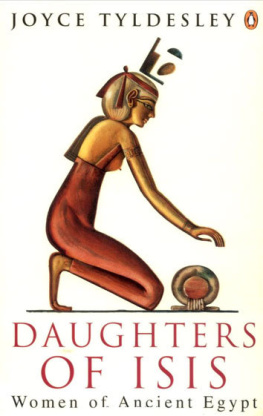Tyldesley - Nefertitis Face : The Creation of an Icon
Here you can read online Tyldesley - Nefertitis Face : The Creation of an Icon full text of the book (entire story) in english for free. Download pdf and epub, get meaning, cover and reviews about this ebook. year: 2018, publisher: LightningSource, genre: Religion. Description of the work, (preface) as well as reviews are available. Best literature library LitArk.com created for fans of good reading and offers a wide selection of genres:
Romance novel
Science fiction
Adventure
Detective
Science
History
Home and family
Prose
Art
Politics
Computer
Non-fiction
Religion
Business
Children
Humor
Choose a favorite category and find really read worthwhile books. Enjoy immersion in the world of imagination, feel the emotions of the characters or learn something new for yourself, make an fascinating discovery.

Nefertitis Face : The Creation of an Icon: summary, description and annotation
We offer to read an annotation, description, summary or preface (depends on what the author of the book "Nefertitis Face : The Creation of an Icon" wrote himself). If you haven't found the necessary information about the book — write in the comments, we will try to find it.
Tyldesley: author's other books
Who wrote Nefertitis Face : The Creation of an Icon? Find out the surname, the name of the author of the book and a list of all author's works by series.
Nefertitis Face : The Creation of an Icon — read online for free the complete book (whole text) full work
Below is the text of the book, divided by pages. System saving the place of the last page read, allows you to conveniently read the book "Nefertitis Face : The Creation of an Icon" online for free, without having to search again every time where you left off. Put a bookmark, and you can go to the page where you finished reading at any time.
Font size:
Interval:
Bookmark:

Joyce Tyldesley is a Senior Lecturer in Egyptology at the University of Manchester, and an Honorary Research Associate of the Manchester Museum. She is the author of many books on ancient Egypt, including Cleopatra, Last Queen of Egypt, which was a Radio 4 Book of the Week and Tutankhamen's Curse: The Developing History of an Egyptian King, which won the 2014 Felicia A. Holton Book Award given by the Archaeological Institute of America.
ALSO BY JOYCE TYLDESLEY
For Adults
Daughters of Isis: Women of Ancient Egypt
Hatchepsut: the Female Pharaoh
Nefertiti: Egypts Sun Queen
The Mummy
Ramesses: Egypts Greatest Pharaoh
Judgement of the Pharaoh: Crime and Punishment in Ancient Egypt
The Private Lives of the Pharaohs
Egypts Golden Empire
Pyramids: The Real Story Behind Egypts Most Ancient Monuments
Tales from Ancient Egypt
Egypt: How a Lost Civilization was Rediscovered
Chronicle of the Queens of Egypt
Egyptian Games and Sports
Cleopatra: Last Queen of Egypt
The Pharaohs
Myths and Legends of Ancient Egypt
Tutankhamens Curse
For Children
Mummy Mysteries: The Secret World of Tutankhamun and the Pharaohs
Egypt (Insiders)
Stories from Ancient Egypt
Stories from Ancient Greece and Rome
The Lost Scroll: A Play for children

JOYCE TYLDESLEY

For all my students, past, present and future.
First published in Great Britain in 2018 by
PROFILE BOOKS LTD
3 Holford Yard
Bevin Way
London WC1X 9HD
www.profilebooks.com
Copyright Joyce Tyldesley, 2018
The moral right of the author has been asserted.
All rights reserved. Without limiting the rights under copyright reserved above, no part of this publication may be reproduced, stored or introduced into a retrieval system, or transmitted, in any form or by any means (electronic, mechanical, photocopying, recording or otherwise), without the prior written permission of both the copyright owner and the publisher of this book.
A CIP catalogue record for this book is available from the British Library.
eISBN 978 1 84765 890 6


I always worry when I start a new book. Is my subject of interest to a wide readership or horrible thought is it simply my own, self-indulgent obsession? With this book, all worries soon evaporated. The Berlin bust which is believed to depict Queen Nefertiti is clearly a subject of interest to many people, and from the outset I have been overwhelmed by the support that I have received from friends, colleagues, students and complete strangers too numerous to mention individually. Thank you all.
The themes developed in this book were first presented in a lecture given to the Egypt Exploration Society in 2010, and refined for a lecture given for the Showcase Seminar series in the Manchester Museum in 2011. I would like to thank both organisations for their support. The delay in writing was caused by an unfortunate series of personal circumstances. I would like to thank all my editors at Profile Books the late Peter Carson, Daniel Crewe, Penny Daniel and Cecily Gayford as well as my copy-editor, Trevor Horwood, for their patience with what must, at times, have seemed like a never-ending project.
Campbell Price, Curator of Egypt and Sudan at the Manchester Museum, never allowed me to give up on Nefertiti. Carolyn Rout-ledge and Angela Thomas, both former Curators of Egyptology and Archaeology at Bolton Museum, each provided helpful information about the Bolton Nefertiti replica. George Rothschild has generously taken the time to discuss his great uncle, Ludwig Borchardt, with me. Michelle, of Southern Artists, Forgers and Hackers, has discussed the creation of the Landis replica bust and Cosmo Wenman has shared his work on the Nefertiti 3D scan heist/hoax. Pauline Norris explained the importance of Thutmoses horse blinker. Amanda Turnbull shared both her art and her library; Joseph Thimes shared his knowledge of DNA; and Dominique Leroux shared the fortuitous finding of a replica Nefertiti in Paris. Robin Snell explained the importance of her Nefertiti tattoo, while Kerry Webb provided random but important support, from thoughts on bald Disney villainesses to links to articles and television programmes, and encouraged me with a series of cheerful postcards when I was on the verge of giving up. My family have gone to extraordinary lengths to support my growing obsession with the Nefertiti bust. In particular my brother, Frank Tyldesley, volunteered (or was volunteered) to make a life-sized limestone replica, just so that I could get some idea of how the original might have been made. My husband, Steven Snape, supported me through my writing and accompanied me to many museums and art galleries on my quest to look at as many different forms of Nefertiti as possible. I am grateful to them all.




One of the most interesting features of modern historical work is the attempt of the historian, not only to construct a complete and reliable skeleton of fact about particular peoples and periods, but also, when that has been done, to clothe the dry bones with flesh and blood, and to inspire them with life and movement. The dry catalogues of events and dynasties which served as histories in the past no longer satisfy us. We wish to know how people lived, acted, thought, in ancient days, to see them as they wrought their days work, to follow them into the intimacies of their homes, to know what they believed in and hoped for, even what amused them in their hours of relaxation. Perhaps even more keenly do we desire to realise individual personality, where such a thing is possible, and to be able to form in our own minds an actual conception of the men who made history in the past.
James Baikie (1929)
As a child, I loved the gloomy Egyptian gallery in Bolton Museum. Here, hidden amongst the countless dusty pots, could be found a whole treasury of wonders: the Rosetta Stone, a partially unwrapped female mummy lying in a decorated coffin, a squat Peruvian mummy sewn into what looked like a sack, and the sculpted head of a beautiful woman named Nefertiti. I dont know how old I was when I realised that not everything on display was quite what it seemed. The Rosetta Stone was much to my indignation a reproduction of the original, which has long been a key piece in the British Museums collection. The Egyptian mummy was genuinely ancient, but would later be reclassified as a man while its decorated coffin remained that of a woman; a useful reminder that not every dead Egyptian made the long journey to Lancashire with his or her own accessories. Nefertitis head was less than a century old; a plaster copy of a bust then on display in West Berlin, and just one of a host of identical plaster Nefertitis confusing children and their parents in museums throughout the Western world. Only the Peruvian mummy the inexplicable and, to me, sinister intruder in the Egyptian gallery was exactly what it appeared to be.
Font size:
Interval:
Bookmark:
Similar books «Nefertitis Face : The Creation of an Icon»
Look at similar books to Nefertitis Face : The Creation of an Icon. We have selected literature similar in name and meaning in the hope of providing readers with more options to find new, interesting, not yet read works.
Discussion, reviews of the book Nefertitis Face : The Creation of an Icon and just readers' own opinions. Leave your comments, write what you think about the work, its meaning or the main characters. Specify what exactly you liked and what you didn't like, and why you think so.



